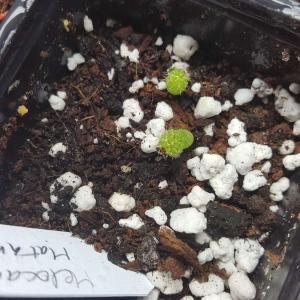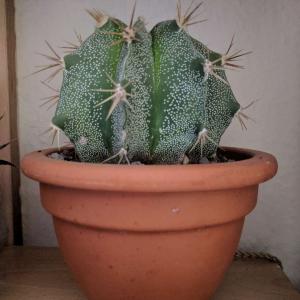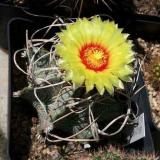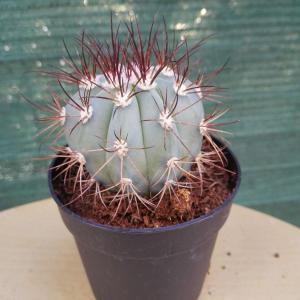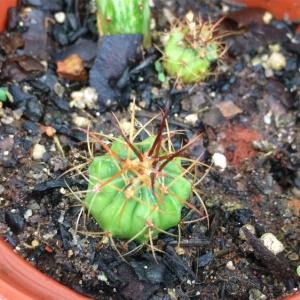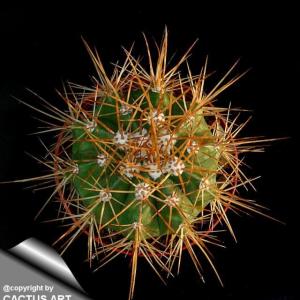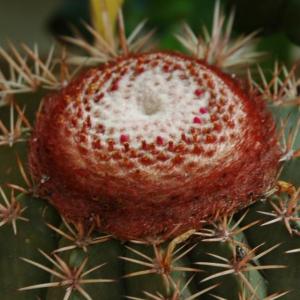文章
Dummer. ゛☀
2017年09月20日

Melocactus is a genus of especially aesthetically interesting cacti, distinguishable by their odd cephalium that protrudes from the top. The cephalium, which is a bristly collection of aureoles, is designed to produce flowers and fruit and can grow up to three feet tall in some cases. Cephaliums are red or white and form small pink flowers inside their mass, and their fruits are waxy and shaped like tubes.
Because of their appearance, Melocactus are popular cacti in cultivation. They are native to places with high temperatures and cannot tolerate frost: in the wild, they grow in various parts of the Caribbean, South America (especially Brazil), and Mexico. Notably, Melocactus plants only develop their distinctive look once they reach maturity.
In the beginning of their lives, their appearance is typical of most cacti—they’re globular and ribbed all over with aureoles. They only develop the cephalium once they’re fully developed, and once it begins growing it won’t stop until the plant itself dies. So they can be hard to identify before they’ve reached maturity. They can be a bit of challenge due to some specificities in their care requirements and are a better choice for experienced cactus growers: nonetheless, they are quite beautiful and extraordinary once fully grown.
Growing Conditions
Light: Lots and lots of bright sunlight is necessary for Melocactus to thrive.
Water: For cacti, they like fairly moist environments, so water regularly, especially during the growing season. Make sure not to let them sit in water to avoid rotting the roots.
Temperature: Warm tropical temperatures above seventy degrees. They cannot survive frost.
Soil: Most cactus potting mixes should work fine, ideally a well-draining mix with some organic material.
Fertilizer: Feed with a balanced, diluted fertilizer like a 20-20-20 mixed into their water during the growing season to help them develop.
Propagation
These cacti are not difficult to propagate from seed. Plant the seeds in well-aerated soil that drains well, and make sure to soak them in warm water before you do. Then seal the new seeds to keep in heat and moisture, which will help them root. Their root systems will take a little while to develop, so don’t overwater or overfeed them before they have the necessary equipment. Remember, always use fresh seed—it should be dry when you get it, before it’s soaked.
Repotting
Notably, Melocactus like to be fairly packed in, so keep them in a fairly small container that slightly constricts their roots. Repotting them at the beginning of the growing season is a good idea until they form cephaliums and the body stops growing, and they should be repotted like other cacti: by lifting the root ball out all at once, cleaning it gently, and replacing it. Make sure not to replant in too large a container to avoid damaging the plant.
Grower’s Tips
These are somewhat finicky cacti with unusual requirements. They shouldn’t be allowed to completely dry out, even in winter, and they can suffer from soil composition, drainage, water level, sun, and more factors that are difficult to control. For that reason, these plants are best for growers who already have had some success cultivating cacti. Establish a balance with good aeration matched by ample water, good soil matched by good drainage, and these plants should continue to grow. If they’re grown successfully, their unusual tops make them among the more beautiful of desert cacti.

Because of their appearance, Melocactus are popular cacti in cultivation. They are native to places with high temperatures and cannot tolerate frost: in the wild, they grow in various parts of the Caribbean, South America (especially Brazil), and Mexico. Notably, Melocactus plants only develop their distinctive look once they reach maturity.

In the beginning of their lives, their appearance is typical of most cacti—they’re globular and ribbed all over with aureoles. They only develop the cephalium once they’re fully developed, and once it begins growing it won’t stop until the plant itself dies. So they can be hard to identify before they’ve reached maturity. They can be a bit of challenge due to some specificities in their care requirements and are a better choice for experienced cactus growers: nonetheless, they are quite beautiful and extraordinary once fully grown.

Growing Conditions
Light: Lots and lots of bright sunlight is necessary for Melocactus to thrive.
Water: For cacti, they like fairly moist environments, so water regularly, especially during the growing season. Make sure not to let them sit in water to avoid rotting the roots.
Temperature: Warm tropical temperatures above seventy degrees. They cannot survive frost.
Soil: Most cactus potting mixes should work fine, ideally a well-draining mix with some organic material.
Fertilizer: Feed with a balanced, diluted fertilizer like a 20-20-20 mixed into their water during the growing season to help them develop.

Propagation
These cacti are not difficult to propagate from seed. Plant the seeds in well-aerated soil that drains well, and make sure to soak them in warm water before you do. Then seal the new seeds to keep in heat and moisture, which will help them root. Their root systems will take a little while to develop, so don’t overwater or overfeed them before they have the necessary equipment. Remember, always use fresh seed—it should be dry when you get it, before it’s soaked.

Repotting
Notably, Melocactus like to be fairly packed in, so keep them in a fairly small container that slightly constricts their roots. Repotting them at the beginning of the growing season is a good idea until they form cephaliums and the body stops growing, and they should be repotted like other cacti: by lifting the root ball out all at once, cleaning it gently, and replacing it. Make sure not to replant in too large a container to avoid damaging the plant.

Grower’s Tips
These are somewhat finicky cacti with unusual requirements. They shouldn’t be allowed to completely dry out, even in winter, and they can suffer from soil composition, drainage, water level, sun, and more factors that are difficult to control. For that reason, these plants are best for growers who already have had some success cultivating cacti. Establish a balance with good aeration matched by ample water, good soil matched by good drainage, and these plants should continue to grow. If they’re grown successfully, their unusual tops make them among the more beautiful of desert cacti.
0
0
求助
saigejaco
2017年07月21日

All of my #melocactus root came out in a repotting incident.. Is there a chance of it growing any roots back?


0
0
saigejaco:@Thomas all i have is this?
Thomas:pouring more nutrient solution on roots it will recovery soon.





